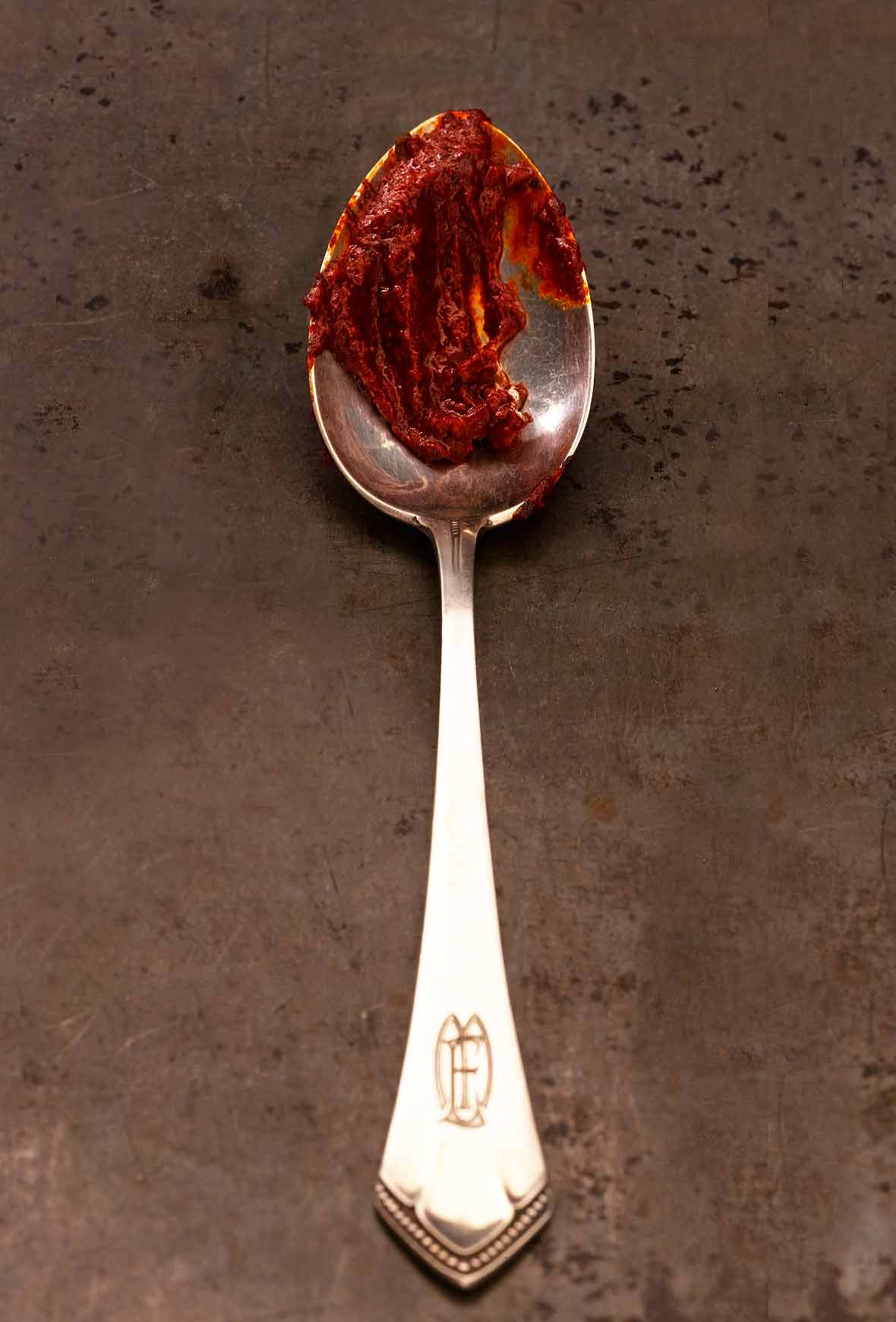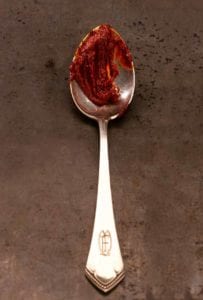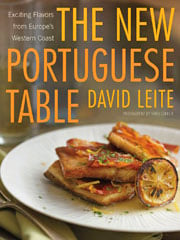
Massa de pimentão is originally from the Alentejo province. The salty red pepper paste, a pantry staple, is a Portuguese classic and constitutes the major flavor component of the region’s cooking. Each cook has his or her own version. Some are made from fresh bell peppers that have been salt-cured, others rely on roasted peppers, still, others turn to paprika. This isn’t the classic version. This is an “amped-up red pepper paste” based upon my family’s recipe. I wanted all the flavors of the Portuguese kitchen in one power punch of a paste.
It’s richly flavored–think of it as a preseasoned rub–so all you have to do to make dinner is rub a little on beef, chicken, fish, or even peeled, halved potatoes before roasting. Although I have to say that this particular paste’s most famous—and deservedly so—application (although granted, I’m a little biased) is my Grandmother Costa’s Bread Dressing.–David Leite
How To Use Portuguese Red Pepper Paste
David explains that red pepper paste is sorta like Asian fish sauce in that a little goes a loooooooong ways. As David mentions above, you can rub a little on a beef roast, chicken (both above and below the skin), fish, even peeled, halved potatoes before before roasting. Or you can stir it into stews or soups. It works wonders when stirred into mayo. And any other application you can imagine where you want or need a little bling. Then let us know how you used it in a comment below.
Want to Save This?

Portuguese Red Pepper Paste
Ingredients
- 2 tablespoons sweet paprika
- 2 tablespoons sweet smoked paprika
- 1/4 cup dry red wine
- 8 to 10 garlic cloves
- 2 Turkish bay leaves, crumbled
- 3 tablespoons tomato paste, or 1 tablespoon double-concentrate tomato paste
- 1 1/2 tablespoons fresh lemon juice
- 7 sprigs cilantro
- 5 sprigs flat-leaf parsley
- 1 1/2 tablespoons kosher salt (16 g)
- 1/4 teaspoon freshly ground white pepper
- Few dashes piri-piri sauce, or to taste
- 1/4 cup olive oil
Instructions
- In a food processor, combine the sweet paprika, sweet smoked paprika, wine, garlic, bay leaves, tomato paste, lemon juice, cilantro, parsley, salt, pepper, and piri-piri sauce.
- Pulse until the garlic and herbs are minced, scraping the sides of the bowl as necessary.
- With the motor still running, add the olive oil in a slow, steady stream and continue whirring until the mixture comes together in a slick, homogeneous paste, 1 to 2 minutes.
- Use the mixture immediately or spoon it into a small glass jar with a tight-fitting lid and refrigerate for up to a month.
Notes
Classic Red Bell Pepper Paste Variation
This classico approach to red bell pepper paste relies on salt-cured bell peppers for oomph. It’s a much saltier version of the paste than the recipe above, so use it with a judicious hand. Wash, stem, and seed 3 red bell peppers. Slice them into 1-inch-wide strips. Line a colander with cheesecloth and pour in about an inch of kosher salt. Press some of the strips into the salt and cover with another inch of salt. Continue layering until all the strips are covered. Top with a heavy pan. Place the colander in a large bowl and set aside at cool room temperature or 5 days. On the 6th day, fish out the bell pepper strips and brush off the salt but do not rinse. Purée in a food processor, transfer to a clean glass jar, and refrigerate until you need your next fix.
Explore More with AI
Nutrition
Nutrition information is automatically calculated, so should only be used as an approximation.
Recipe Testers’ Reviews
While the recipe title may conjure up a pile of roasted red bell peppers with charred skins, this smoky paprika paste has none of those. In a very short 15 minutes of time, you will have a lovely red paste that can enhance the taste of chicken, pork, even some chicken noodle soup.
The smoky paprika flavor dominates the flavor profile. We stirred it into some homemade chicken noodle soup and it really amped up the flavor. Searching for how else to use it, we tried on chicken and sautéed shrimp. Coating it on chicken breast in the final minutes of cooking would be a delicious addition. Other ideas would be to mix with a bit of mayonnaise for a sandwich spread or create sauce for pork tenderloin. I think you could even make a vinaigrette for a salad with the addition of a nice and mild vinegar like cider, rice, or white wine vinegar.










Portuguese “massa de pimentão” has 3 ingredients. Paprika, salt, and olive oil. But to make it happen you need to cut big chunks of paprika and add loads of salt and press them and leave them aside for some days. Then you blend. With that paste there is then different other pastes that can be done, including the famous Vinha d’Alhos from the name of the Indian dishes Vindaloo comes from.
Jorge, you’re absolutely right! This is not massa de pimentão. This is my creation, based upon what my family makes from my father’s own massa de pimentão, for those who aren’t able to get to a Portuguese market. I wanted one paste that had all the flavors of the Portuguese kitchen in it. In my cookbook, I have a recipe for the classic version. I’ll clear this up in the headnote.
This is heaven in a jar. There’s always some in my fridge and there are so, so many ways I use it. I have two favorites. You are absolutely right (as you so frequently are!) about stirring it into mayonnaise. With roasted potatoes, that’s divine. My other favorite use is to make massa de pimentão butter. It’s wonderful on steak or rubbed into chicken, melted over asparagus, green beans, woodchips! For breakfast, I smear some of the butter on good toast and top with mashed avocado. Okay, I need a moment…thanks for posting this.
Goddess, I couldn’t agree with you more! And I love your idea of massa de pimentão butter. Must. Try. Now!!
I have made this pepper paste on multiple occasions, and every time I do, I am blown away by how flavourful it is for such minimal effort. It’s an excellent condiment to have on hand for last minute meals — adding a rich smoky-tangy depth and gorgeous hue to meats or veggies. I recently used it as a marinade for pork bifanas (and a side of pepper paste-rubbed roasted potatoes) and it was fantastic. Be sure to save some extra paste for the irresistible bread dressing mentioned in the headnotes of this recipe! A definite winner in this household.
Allegra, boy, does that bifana makes me so hungry andSaudades saudades de Lisboa (a longing to be back in Lisbon). Marvelous!